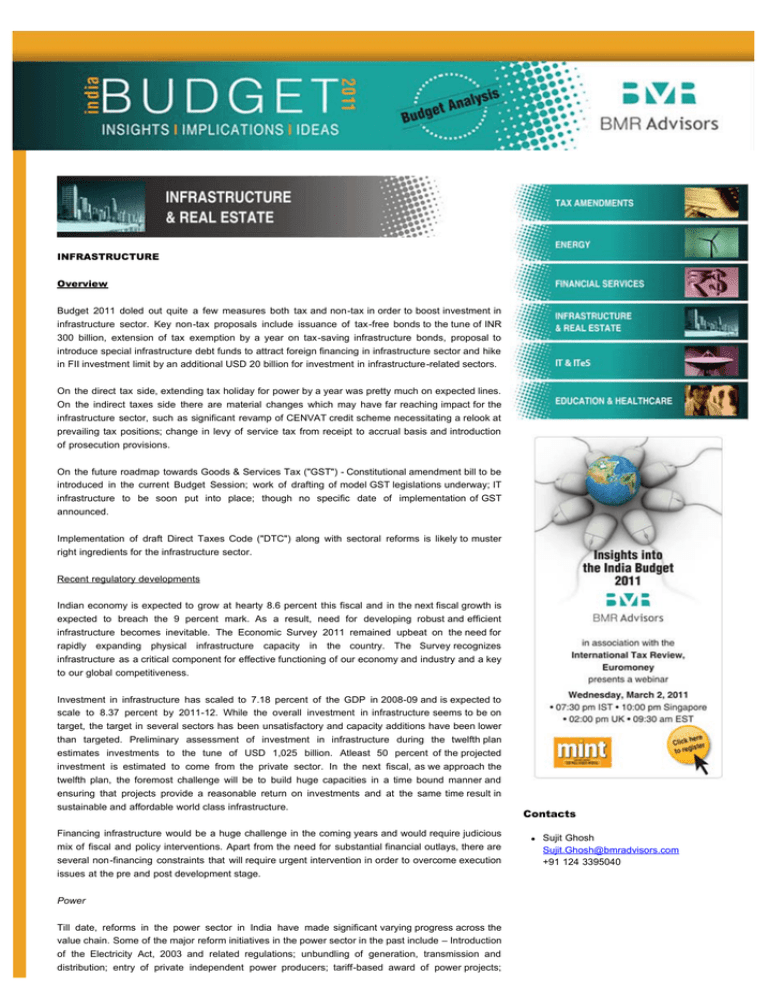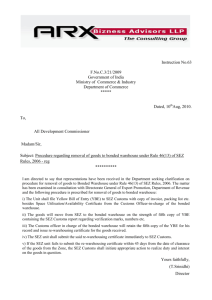
INFRASTRUCTURE
Overview
Budget 2011 doled out quite a few measures both tax and non-tax in order to boost investment in
infrastructure sector. Key non-tax proposals include issuance of tax-free bonds to the tune of INR
300 billion, extension of tax exemption by a year on tax-saving infrastructure bonds, proposal to
introduce special infrastructure debt funds to attract foreign financing in infrastructure sector and hike
in FII investment limit by an additional USD 20 billion for investment in infrastructure-related sectors.
On the direct tax side, extending tax holiday for power by a year was pretty much on expected lines.
On the indirect taxes side there are material changes which may have far reaching impact for the
infrastructure sector, such as significant revamp of CENVAT credit scheme necessitating a relook at
prevailing tax positions; change in levy of service tax from receipt to accrual basis and introduction
of prosecution provisions.
On the future roadmap towards Goods & Services Tax ("GST") - Constitutional amendment bill to be
introduced in the current Budget Session; work of drafting of model GST legislations underway; IT
infrastructure to be soon put into place; though no specific date of implementation of GST
announced.
Implementation of draft Direct Taxes Code ("DTC") along with sectoral reforms is likely to muster
right ingredients for the infrastructure sector.
Recent regulatory developments
Indian economy is expected to grow at hearty 8.6 percent this fiscal and in the next fiscal growth is
expected to breach the 9 percent mark. As a result, need for developing robust and efficient
infrastructure becomes inevitable. The Economic Survey 2011 remained upbeat on the need for
rapidly expanding physical infrastructure capacity in the country. The Survey recognizes
infrastructure as a critical component for effective functioning of our economy and industry and a key
to our global competitiveness.
Investment in infrastructure has scaled to 7.18 percent of the GDP in 2008-09 and is expected to
scale to 8.37 percent by 2011-12. While the overall investment in infrastructure seems to be on
target, the target in several sectors has been unsatisfactory and capacity additions have been lower
than targeted. Preliminary assessment of investment in infrastructure during the twelfth plan
estimates investments to the tune of USD 1,025 billion. Atleast 50 percent of the projected
investment is estimated to come from the private sector. In the next fiscal, as we approach the
twelfth plan, the foremost challenge will be to build huge capacities in a time bound manner and
ensuring that projects provide a reasonable return on investments and at the same time result in
sustainable and affordable world class infrastructure.
Financing infrastructure would be a huge challenge in the coming years and would require judicious
mix of fiscal and policy interventions. Apart from the need for substantial financial outlays, there are
several non-financing constraints that will require urgent intervention in order to overcome execution
issues at the pre and post development stage.
Power
Till date, reforms in the power sector in India have made significant varying progress across the
value chain. Some of the major reform initiatives in the power sector in the past include – Introduction
of the Electricity Act, 2003 and related regulations; unbundling of generation, transmission and
distribution; entry of private independent power producers; tariff-based award of power projects;
Contacts
Sujit Ghosh
Sujit.Ghosh@bmradvisors.com
+91 124 3395040
trading and merchant power sales, development of national grid; open access; spot and futures
market and so on. Nonetheless the reform remains incomplete.
Given the massive future investment requirements and the critical role of the power sector in
sustaining growth, the Economic Survey 2011 has called for some bold reforms in this sector.
The Survey emphasizes the need for reforms in the following three directions:
Strengthening independent regulators to ensure and promote adequate competition, balance
interests and enhance the working of the market.
Improving distribution and opening bulk supply to competition ie PPP mode with open access,
long term concessions to private distribution companies; distribution franchisee mode where
ownership of asset remains with the State; defining performance standards for State
distribution companies.
Revising electricity tariffs to more economic levels and reducing subsidies and cross-subsidies.
Policy announcements
Plan allocation for infrastructure sector increased from INR 1.74 trillion in 2010-11 to INR 2.14
trillion for 2011-12.
Elevation in Rural Infrastructure Development Fund corpus from INR 160 billion in 2010-11 to
INR 180 billion for 2011-12. The additional allocation to be used for creation of warehousing
facilities.
Plan allocation of INR 580 billion towards the flagship programme Bharat Nirman.
In the coming year 2011-12, tax-free bonds amounting to INR 300 billion have been proposed
to be introduced by various Government undertakings, including Indian Railway Finance
Corporation, National Highway Authority of India, HUDCO and Ports, with a view to support
infrastructure development in railways, ports, housing and highways development.
Creation of special purpose vehicle in the form of notified infrastructure debt funds to attract
foreign funds for infrastructure financing.
FII limit for investment in corporate bonds, with residual maturity of over five years issued by
companies in infrastructure sector raised by an additional limit of USD 20 billion taking the limit
to USD 25 billion.
FIIs permitted to invest in unlisted bonds with a minimum lock-in period of three years.
However, the FIIs will be allowed to trade amongst themselves during the lock-in period.
The Government proposes to come up with comprehensive policies in developing publicprivate-partnerships that can be used by the Central and the State Government for creation of
public sector assets.
Key tax proposals
Direct tax
Developers of Special Economic Zones ("SEZ") and SEZ units have been proposed to be
brought within the ambit of Minimum Alternate Tax ("MAT") and Dividend Distribution Tax
("DDT") with effect from April 1, 2011 and June 1, 2011 respectively. Introduction of MAT and
DDT (with marginal increase in the MAT rate by 50 basis points) is set to unwind the tax-free
status for such companies.
For the purpose of attracting long-term and low cost foreign funds, it is proposed to facilitate
setting up of special vehicles in the form of notified infrastructure debt funds (to be notified by
the Central Government and set up in accordance with the prescribed guidelines) resting upon
the following beneficial proposals:
Income of such debt funds to be exempt from tax.
Interest received by non-residents from such debt funds to attract concessional
withholding tax rate of 5 percent.
The scheme for deduction to the extent of INR 20,000 (over and above the overall limit of INR
100,000 pertaining to the tax deduction on savings) currently available under section 80CCF
for investments in notified long-term infrastructure bonds has been proposed to be extended for
the financial year 2011-12 as well.
The scope of 'specified business' eligible for deduction under section 35AD has been proposed
to be expanded to include the business constituting developing and building housing project
under the affordable housing scheme (to be framed by the Central Government and notified by
CBDT) from April 1, 2011. Similar provisions have been proposed to be introduced for the
business of production of fertilizer in India.
The use of the words 'new hotel' and 'new hospital' for the purpose of the 'specified business'
under section 35AD created certain ambiguity concerning set off of the losses of hotels and
hospitals under section 73A which permits set off of the losses of a 'specified business' against
the profits of other 'specified business'. The proposed substitution of the words 'hotel' and
'hospital' resolves the ambiguity.
The terminal date for the commencement of specified operations by companies engaged in
generating and distribution of power or laying transmission/ distribution lines (eligible for
deduction under section 80IA) has been extended for a further period of one year till
March 31, 2012.
Indirect tax
Power
Exemption of excise duty extended to machineries and equipments required for development
of auxiliary facilities such as ash disposable system, water intake, treatment and storage
facilities and coal transportation facilities of such project, whether located inside or outside the
Power Plant. Benefit also extended to power cables connecting generator to the transformer
within the power plant.
Similar exemption from customs duty mentioned in the explanatory notes to customs. However,
unlike excise no formal notification has been issued in the context of customs yet.
The customs explanatory note clarifies that no exemption on steel and cement required for
construction of Power Project shall be available. However, no specific notification/ circular has
been issued in this regard.
Excise exemption granted on goods required for brownfield expansion of Mega Power Project.
While recently a concessional rate of customs duty was prescribed for goods requied for
expansion of brownfield Mega Power Project, no corresponding exemption was provided under
excise. Vide Notification 6/ 2011-CE, complete exemption from excise duty has now been
provided for such goods.
Credit on goods used in a captive power plant outside the factory specifically allowed.
Exemption of excise duty on goods supplied to 'ultra mega power projects' and 'mega power
projects' delinked from customs duty exemption; however benefit still restricted to goods
covered under Chapter 9801 of Customs Tariff.
Transport
Customs duty exemption extended to tunnel boring machines and part and components thereof
for constucion of national highway projects.
Complete exemption from Basic Customs Duty ("BCD") available on import of aircraft by nonscheduled operators whether for passenger services or chartered services has been withdrawn
and such imports would now attract BCD at the rate of 2.5 percent. Also exemption from
education cess and secondary and higher education cess presently available to aircrafts is
being withdrawn. Hence the effective rate of customs duty would be 2.575 percent.
Exemption in respect of railway locomotives has been withdrawn. These goods are now
subjected to excise duty of 5 percent ad-valorem or 1 percent ad-valorem (provided that the
manufacturer does not avail the CENVAT credit of inputs/ input services).
Exemption has been provided on services in the nature of Works Contract, if performed wholly
within the airport.
Exemption has been provided on services in the nature of construction, repair, alteration and
renovation of wharves, quays, docks, stages, jetties, piers and railways, if performed wholly
within the port or other ports.
Exemption from service tax (under the taxable category of transport of goods by air travel)
granted for import cargo to the extent of amount of air freight which is included in the value for
customs duty purposes.
Service tax applicable in respect of transport of passengers by air service revised as follows:
Domestic (economy): From INR 100 to INR 150
International (economy): From INR 500 to INR 750
International/ Domestic (other than economy): Standard rate of 10 percent plus cess
Water supply projects
Customs duty exemption earlier available for water supply project has been extended for water
pumping stations and water storage facilities (reservoir).
Other proposals
Point of taxation rules, to be effective from April 1, 2011, would inter alia change levy of service
tax from receipt to accrual basis. This may significantly impact the working capital and
compliance requirements for the businesses.
The definition of input and input service have been amended to exclude goods and services
used for setting up factory of a manufacturer/ premises of a service provider, except when such
goods/ services are being supplied by a sub-contractor to a main contractor. This may enhance
the input tax cost resulting into higher capex cost for Project Owners.
Credit in the hands of main contractor, providing services under Works Contract category and
opting to pay Service Tax under the composition scheme, restricted to 40 percent when subcontractor does not claim any abatement/ deduction and pays Service Tax on the entire value
of the contract after claiming credit on inputs.
Cement, which hitherto was liable to Excise Duty at specified rate, is now subjected to both
specific rate and ad-valorem rate.
CENVAT credit has been allowed on services provided to SEZ developers/ units; this was a
longstanding industry demand to ensure tax parity between goods and services supplied to
SEZ developers/ units.
Service Tax exemption/ refund scheme for SEZs rationalized. Concept of services 'wholly
consumed' within the SEZ explained.
CENVAT credit on ship breaking industry restricted to 85 percent of the Countervailing Duty
("CVD"). Ship breaking being a significant source of steel for infrastructure sector, this may
adversely impact the cost of procurement of steel.
BMR comments
Clearly, infrastructure sector, besides the financial services sector, was the focus for majority of
significant policy announcements. Given the importance of this sector for sustaining the economic
growth trends, and enhanced emphasis on infrastructure investments in the Twelfth Plan, Budget
proposals (both tax and non-tax measures) are likely to provide much needed fillip to this sector.
Real Estate
Overview
While the Real Estate sector has recovered from the lows of previous years, yet there are significant
challenges in the short to medium term and hence the expectations of the industry from the Budget
2011 were high. The expectations ranged from policy initiatives to ease up the liquidity crunch to tax
incentives to boost demand. In the backdrop of these expectations, the key tax provisions on the
taxation front impacting the real estate sector include the removal of MAT and DDT exemptions for
SEZ developers and introduction of some investment linked incentives for the affordable housing
sector. On the policy front, the interest subvention scheme has been extended with an upward
revision to the existing caps. Similarly, housing loans upto INR 2.5 million in urban areas have been
treated as priority sector lending. Further, it is proposed to set up Mortgage Risk Guarantee Fund to
enhance credit worthiness of economically weaker section and Low Income Group households to
enable a greater flow of housing credit to this section.
Key tax proposals
Direct tax
MAT and DDT exemptions hitherto available to SEZ developers have been withdrawn. Hence,
with the Budget 2011 proposals, the SEZ Developers who were not paying any tax on the
profits from the SEZ development due to corporate tax, MAT and DDT exemptions are now
required to pay MAT at 18.5 percent on their book profits and in addition are required to pay
DDT at 15 percent on dividend distributions post June 1, 2011.
SEZ Units that were hitherto not liable to MAT would also be subjected to MAT on their book
profits. This would have an adverse impact on the marketability of SEZs developed/ being
developed by SEZ developers. This change is again in line with the proposal in the DTC.
Applicability of MAT on profits of SEZ developers and SEZ units has also been extended to
Limited Liability Partnerships ("LLPs") and hence going forward such LLPs would be subject to
MAT on their adjusted taxable income.
Budget also proposes an investment linked deduction in respect of expenditure incurred in
developing and building a housing project under notified scheme for affordable housing.
Indirect tax
Service tax
Two new services are proposed to be brought into the service tax net with effect from the date
of enactment of Finance Bill.
Services provided by air-conditioned restaurants having license to serve liquor will also
be now liable to service tax, with 70 percent abatement towards the sale of meals and
beverages portion. The effective rate of service tax on the consolidated food bills would
be 3.09 percent. Mere sale of food by way of pick-up or home delivery and goods sold at
MRP are kept out of this levy.
Short term accommodation provided by hotels, inns, clubs, guest houses, etc for a
continuous period of stay of less than 3 months, with declared tariff of INR 1,000 per day
or higher will now be liable to service tax with a proposed abatement of 50 percent,
making the effective rate of tax at 5.15 percent.
The service tax exemption notification for services received by the SEZ units and developers
has been revamped.
The basic two fold structure (i) of granting upfront exemption to services used for
authorised operations and "wholly consumed" within the SEZ; and (ii) of granting refunds
for services used for authorised operations that are not so wholly consumed remains; the
criteria for the determination of "wholly consumed" services, which enjoy upfront
exemption, has been laid out by borrowing the criteria from the Export of Services Rules,
2005.
All services received by an entity in a SEZ (ie SEZ Developer or Unit), which does not
have any other operations in domestic tariff area, will constitute "wholly consumed"
services, eligible for upfront exemption.
Refund of the remaining services which are not wholly consumed within the SEZ are
made available on pro rata basis ie ratio of SEZ turnover to total turnover of the entity.
Taxable services provided to an SEZ unit/ developer without payment of service tax are
treated as "zero rated" and restrictions relating to "exempt services" will not apply.
CENVAT credit
No CENVAT credit would be available to a manufacturer or a service provided on goods used
for construction of a building or civil structure; or laying of foundation or making of structures for
support of capital goods. CENVAT credit on these goods would however be available when
they are used for the provision of Port services, other Port services, Airport services,
Commercial or Industrial Construction service, Construction of Residential Complex services,
Works Contract services.
No CENVAT credit would be available to a manufacturer or a service provided of the service
tax paid on Architect services, Port services, other Port services, Airport services, Commercial
or Industrial Construction service, Construction of Residential Complex services, Works
Contract services ("specified services") used for construction of a building or civil structure; or
laying of foundation or making of structures for support of capital goods. Credit of service tax
paid on these services would however be available when these services are used for the
provision of the above mentioned specified services.
CENVAT credit has been restricted to 40 percent of the tax paid on input services relating to
erection, commissioning & installation; commercial or industrial construction and construction of
residential complex, in case tax has been paid on full value of the service after availing
CENVAT credit on inputs, when received by an assessee opting to pay service tax under the
works contract (Composition Scheme for Payment of Service Tax) Rules, 2007). This has been
done to ensure that the credit on inputs is not availed of indirectly while availing of the
composition scheme.
Central Sales Tax
Rate of Central Sales tax on "Declared Goods" including iron and steel has been increased
from 4 percent to 5 percent.
BMR comments
While the impact of Budget proposals is being debated, the real estate sector seems to have
lost significant ground vis-à-vis other sectors. Withdrawal of MAT and DDT exemptions for SEZ
developers is a dampener and is likely to neutralize income tax incentives for SEZs. While the
policy measures announced are largely in line with expectations, the implementation of the
same will need close monitoring to yield intended outcomes.
Please Contact :
Abhishek Goenka, Abhishek.Goenka@bmradvisors.com, +91 80 40320100
© Copyright 2011, BMR Advisors. All Rights Reserved
Disclaimer: This newsletter has been prepared for clients and firm personnel only. It provides general information and guidance as on date of preparation and
does not express views or expert opinions of BMR Advisors. The newsletter is meant for general guidance and no responsibility for loss arising to any person acting
or refraining from acting as a result of any material contained in this newsletter will be accepted by BMR Advisors. It is recommended that professional advice be
sought based on the specific facts and circumstances. This newsletter does not substitute the need to refer to the original pronouncements.








